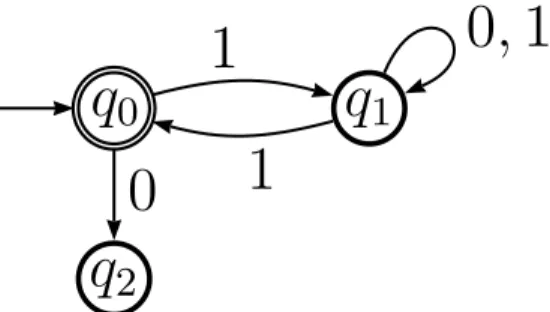Homework 4
Finite Automata on Infinite Words and Trees Winter semester, 2009-2010 Exercise 1(10 points). Anondeterministic M¨uller automatonis defined just like a normal (deterministic) M¨uller automaton except we allow several initial states and use an arbitrary transition relation instead of a transition function.
Show that every language L which is recognized by some nondeterministic M¨uller automaton is also recognized by a nondeterministic B¨uchi automaton, and hence by McNaughton’s theorem, by a standard deterministic M¨uller automaton.
Exercise 2 (30 points). An idea for producing a simple determinization procedure for B¨uchi automata is to keep track both of the sets of reachable states, as in the standard power set construction, and also the set of states which are reached via final states since the last “reset” point. A run is accepting is we “reset” infinitely often. This construction can be seen as a much simpler version of Safra’s construction, in which we have only one extra level, and a single child. Formally, given a B¨uchi automaton A = (Q,Σ, T, I, F), we would construct the deterministic B¨uchi automaton A′ = (Q′,Σ, T′, I′, F′) where:
• Q′ ={(X, Y, m)|Y ⊆X ⊆Q, m∈ {marked, unmarked} }
• T′((X, Y, m), a) is computed as follows:
1. First, we set m to unmarked.
2. Second, we add X∩F to the set Y.
3. Third, we apply the standard power set construction to both X and the newY.
4. Fourth, if X and Y are now equal, we set Y =∅ and m= marked.
• I′ ={(I,∅,unmarked)}
• F′ ={(X,∅,marked)}
You will show that this construction is sound, e.g. no “bad” strings are accepted, but not complete, e.g. some “good” strings may not be accepted.
1. Find a B¨uchi automaton A such thatL(A)6⊆ L(A′).
2. Prove that L(A′)⊆ L(A).
Exercise 3(30 points). We now try to remedy the problem we identified with the approach from Exercise 2. The idea is to iterate the construction: we can now have several levels, but still only one child per level. An accepting run is one in which there is some level k which is always non-empty starting from some point in the run, and such that we “reset” to this level infinitely often.
Formally, for a B¨uchi automatonA= (Q,Σ, T, I, F), we would construct the Rabin automaton A′ = (Q′,Σ, T′, I′,Ω) where:
• Q′ is the set of tuples (X1, X2, . . . , Xn, m) where:
– n=|Q|+ 1
– Xn ⊆Xn−1 ⊆. . .⊆X2 ⊆X1 ⊆Q
– if Xk+16=∅, then Xk+1 must be a proper subset of Xk
– m : {1, . . . , n} → {marked, unmarked} specifies which levels are marked with the special symbol
• T′((X1, . . . , Xn, m), a) is computed as follows:
1. First, we set m(x) = unmarked for all 1≤i≤n.
2. Second, we add Xi∩F to the set Xi+1 for every i < n.
3. Third, we apply the standard power set construction to all of the (possibly modified) sets Xi.
4. Fourth, if some sets Xi and Xi+1 are now equal, and i is the smallest value with this property, then we set Xj = ∅ for all j ≥i+ 1 andm(i) = marked.
• I′ ={(I,∅, . . . ,∅, m)} where m(k) = unmarked for every level k
• Ω ={(E1, F1), . . . ,(En, Fn)} where:
– Ei ={(X1, . . . , Xn, m)|Xi =∅}
– Fi ={(X1, . . . , Xi,∅, . . . ,∅, m)}where m(i) = marked
You will show that this construction is indeed complete, unlike the previous one, but unfortunately not sound.
1. Show that for the B¨uchi automatonA ={{q0, q1, q2},{a, b},{(q0, a, q0), (q0, b, q0),(q0, b, q1),(q0, a, q2),(q1, a, q2),(q2, b, q2)},{q0},{q1, q2}}, we have L(A′)6⊆ L(A). Hint: consider the string (ba)ω.
2. Prove that we always haveL(A)⊆ L(A′).
Exercise 4 (30 points). Apply in a step-by-step manner Safra’s procedure to the B¨uchi automaton in Figure 1. Show that the resulting Rabin automaton recognizes the same language as the original B¨uchi automaton.
q
0q
1q
21 0 1
0 , 1
Figure 1: Automata for Exercise 4
